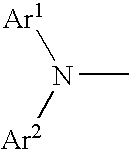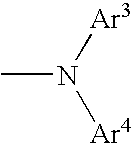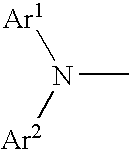Aromatic amine derivative and organic electroluminescence element
an organic electroluminescence element and aromatic amine technology, applied in the direction of luminescent screen of discharge tube, organic semiconductor device, natural mineral layered product, etc., can solve the problems of reducing the efficiency of light emission, increasing the voltage for driving, and reducing the life of light emission, so as to increase the yield in production and suppress the crystallization of molecules
- Summary
- Abstract
- Description
- Claims
- Application Information
AI Technical Summary
Benefits of technology
Problems solved by technology
Method used
Image
Examples
example 1
Synthesis of N,N-diphenyl-1-amino-N,N-dibiphenylyl-4-aminobenzene (Hi)
(1) Synthesis of di-4-biphenylylamine
[0104] Into a 100 ml three-necked flask, 10.0 g of 4-bromobiphenyl (manufactured by TOKYO KASEI KOGYO Co., Ltd.), 4.32 g of sodium t-butoxide (manufactured by WAKO Pure Chemcal Industries, Ltd.) and 42 mg of palladium acetate (manufactured by WAKO Pure Chemcal Industries, Ltd.) were placed. After a stirrer rod was placed into the flask containing the above substances, rubber caps were fitted to the two openings at the sides, and a Dimroth condenser for refluxing was fitted to the opening at the center. A three-way stopcock and a balloon containing argon gas were successively attached to the top of the Dimroth condenser. The system was purged with the argon gas in the balloon three times using a vacuum pump.
[0105] Then, 60 ml of dehydrated toluene (manufactured by WAKO Pure Chemcal Industries, Ltd.), 2.04 ml of benzylamine (manufactured by TOKYO KASEI KOGYO Co., Ltd.) and 169...
example 2
Synthesis of N,N-diphenyl-4-amino-N′,N′-dibiphenylyl-4′-amino-1,1′-biphenyl (H2)
(1) Synthesis of 4′-bromo-N,N-dibiphenyl-4-amino-1,1′-biphenyl
[0117] Under a stream of argon, 10 g of di-4-biphenylylamine obtained in Example 1 (1), 9.7 g of 4,4′-dibromobiphenyl (manufactured by TOKYO KASEI KOGYO Co., Ltd.), 3 g of sodium t-butoxide (manufactured by HIROSHIMA WAKO Co., Ltd.), 0.5 g of bis(triphenylphosphine)palladium(II) chloride (manufactured by TOKYO KASEI KOGYO Co., Ltd.) and 500 ml of xylene were placed into a reactor, and the reaction was allowed to proceed at 130° C. for 24 hours.
[0118] After the reaction mixture was cooled, 1,000 ml of water was added, and the resultant mixture was filtered through a Celite filter. The filtrate was treated by extraction with toluene and dried with anhydrous magnesium sulfate. The resultant solution was concentrated under a reduced pressure, and the obtained crude product was purified in accordance with the column chromatography and recrystall...
example 3
Synthesis of N,N-diphenyl-4-amino-N″,N″-dibiphenylyl-4″-amino-p-terphenyl (H3))
(1) Synthesis of 4″-bromo-N,N-dibiphenylyl-4-amino-p-terphenyl
[0122] Under a stream of argon, 10 g of di-4-biphenylylamine (manufactured by TOKYO KASEI KOGYO Co., Ltd.), 12.1 g of 4,4″-dibromo-p-terphenyl (manufactured by LANCASTER Company), 3 g of sodium t-butoxide (manufactured by HIROSHIMA WAKO Co., Ltd.), 0.5 g of bis(triphenylphosphine)palladium(II) chloride (manufactured by TOKYO KASEI KOGYO Co., Ltd.) and 500 ml of xylene were placed into a reactor, and the reaction was allowed to proceed at 130° C. for 24 hours.
[0123] After the reaction mixture was cooled, 1,000 ml of water was added, and the resultant mixture was filtered through a Celite filter. The filtrate was treated by extraction with toluene and dried with anhydrous magnesium sulfate. The resultant solution was concentrated under a reduced pressure, and the obtained crude product was purified in accordance with the column chromatography ...
PUM
| Property | Measurement | Unit |
|---|---|---|
| transmittance | aaaaa | aaaaa |
| work function | aaaaa | aaaaa |
| transmittance | aaaaa | aaaaa |
Abstract
Description
Claims
Application Information
 Login to View More
Login to View More - R&D
- Intellectual Property
- Life Sciences
- Materials
- Tech Scout
- Unparalleled Data Quality
- Higher Quality Content
- 60% Fewer Hallucinations
Browse by: Latest US Patents, China's latest patents, Technical Efficacy Thesaurus, Application Domain, Technology Topic, Popular Technical Reports.
© 2025 PatSnap. All rights reserved.Legal|Privacy policy|Modern Slavery Act Transparency Statement|Sitemap|About US| Contact US: help@patsnap.com



